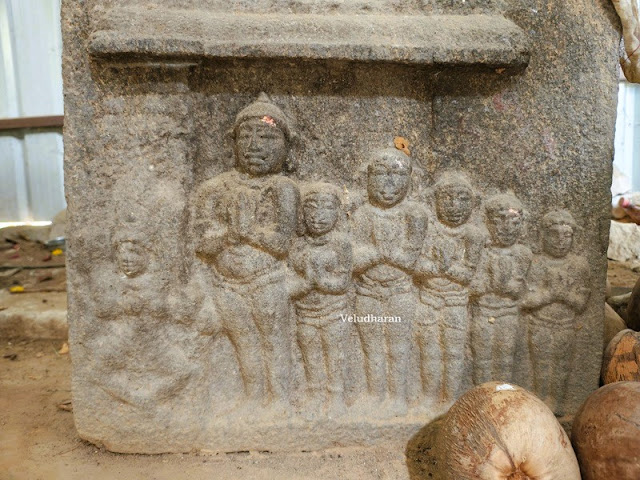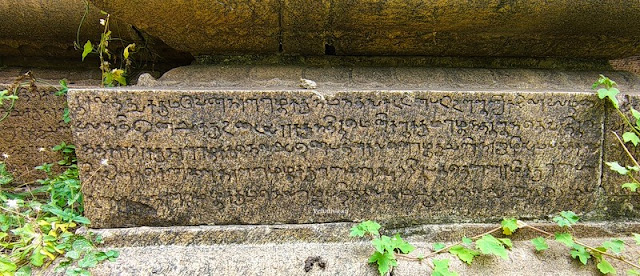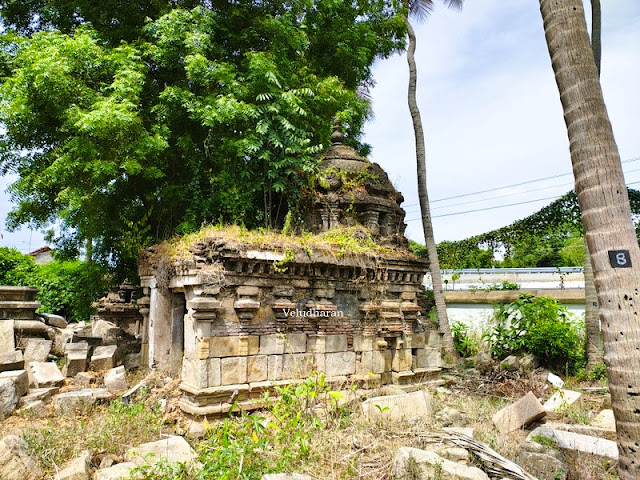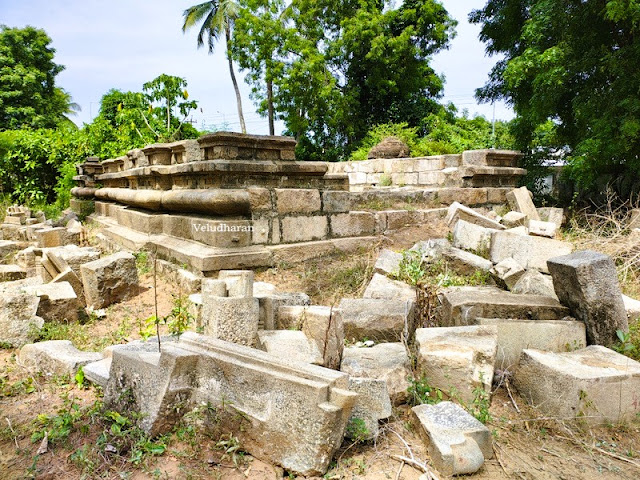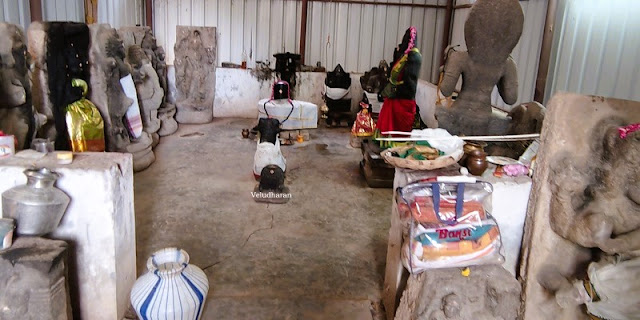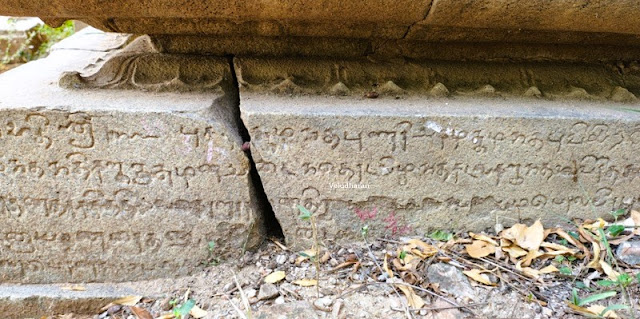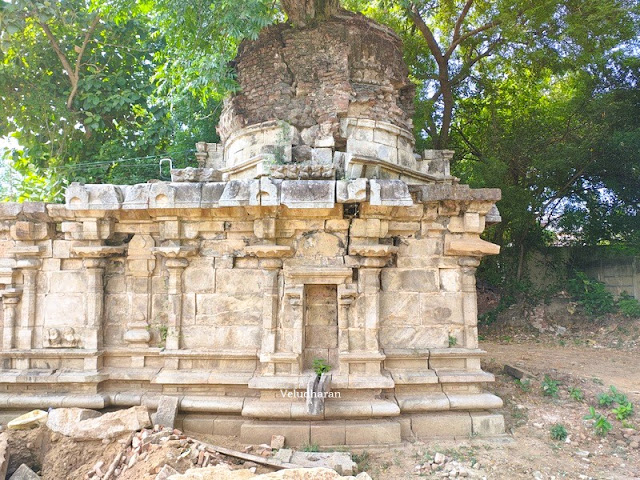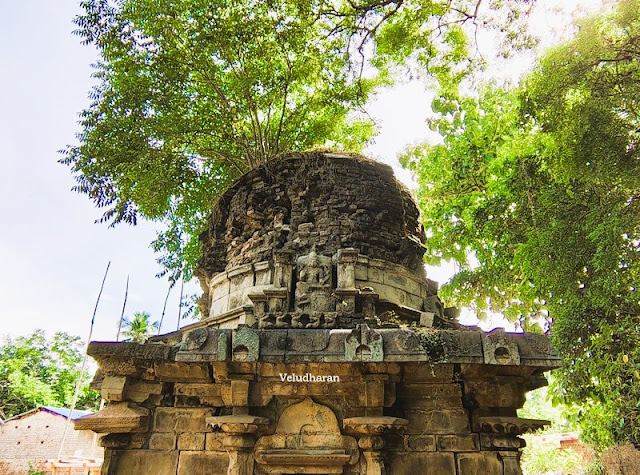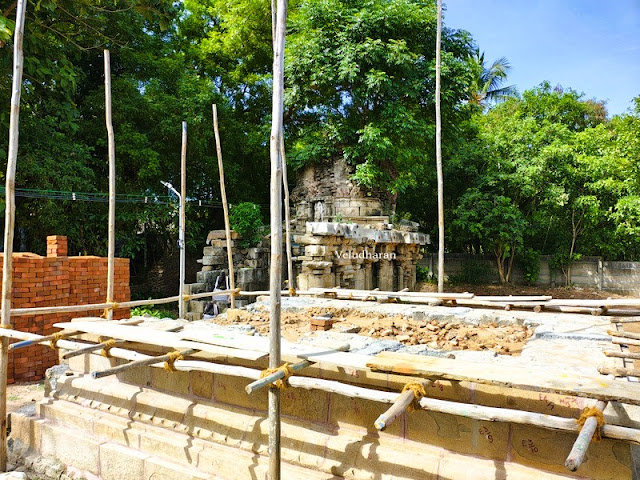The
Visit to this Sri Naganathaswamy Temple at Manambadi was a part
of Rajendra Chozha War Trophy Trail, a Heritage walk organised by the
Kumbakonam Vattara Varalatru Aayvu Sangam -
கும்பகோணம் வட்டார வரலாற்று ஆய்வு சங்கம்
on
28th and 29th September 2024. The temple is in
dilapidated condition. The stones above the adhistanam are scattered around the
temple.
Moolavar: Sri Naganathaswamy
Some
of the salient features of this temple are….
The
temple is facing east, only with adhistanam. The Shiva Lingam, Balipeedam, and
Koshta images are shifted to the Shed. The Koshta images are Vinayagar,
Natarajar, Dakshinamurthy, Rishabanthigar, Lingothbavar, Brahma, Durgai, Ganga Visarjanar, Pichadanar,
and Maha Vishnu.
The
Parivara deities Chandikeswarar, Chandran, Suriyan, Bairavar,
ARCHITECTURE
The
dilapidated temple consists of Sanctum Sanctorum, antarala and ardha mandapam.
The adhistanam is only exists now. The Sanctum Sanctorum is ona pada bandha
adhistanam with jagathy, three vrudha kumudam and pattikai. The bhitti starts
with vedikai. The Koshtas are padra Koshtas.
The temple facing east comprises a Sanctum Sanctorum, ardha mandapam (quasi-pavilion), and mukha mandapam (facade pavilion). The devakostas (niches) of the temple contained images of Pichadanar, Nataraja, Vinayaka, and Dakshinamurthy. Lingodbhava, Brahma, Durga, and Gangadharamurthy. The makara torana over the northeastern niche contains the image of an elephant offering puja to Shiva. The Shiva Lingam is shaded by a tall tree and the same is identified to be the jamun tree (naval maram). On the rear side of the Shiva Lingam is shown a female image who is identified as river Kaviri.
HISTORY
AND INSCRIPTIONS
முதலாம் இராஜேந்திரசோழன் காலத்தில் கட்டப்பட்ட இக்கோயில் திருக்கைலாயம்
எனும் நாகநாத சுவாமி கோயிலாகும். இங்கு முதலாம் இராஜேந்திரசோழனின் ஆறு
கல்வெட்டுக்கள் மற்றும் முதலாம் குலோத்துங்கனின் மூன்று கல்வெட்டுக்களும்
இடம்பெற்றுள்ளது. முதலாம் இராஜேந்திர சோழனின் ( பொயு 1012 முதல்
1044 வரை ), கல்வெட்டொன்றில் இவ்வூர்
இழஞ்சிக்குடி வீரநாராயணபுரம் என்று அழைக்கப்பட்டது. எனவே இக்கோயில் சுமார் 1000
ஆண்டுகள் பழமையான கோயில் எனலாம். இங்கு இக்கோயிலின் தென்புறம்
கோஷ்டத்தில் உள்ள நடராஜரை இராஜேந்திரசோழன் வணங்குவது போன்று காணப்படுகின்றது.
இக்கோயில் கருவறை, அர்த்தமண்டபம். முன்மண்டபம்
என்ற அமைப்பில் கிழக்கு நோக்கி கட்டப்படு உள்ளது. தேவகோஷ்டங்களில் பிச்சாடனார்,
நடராசர், விநாயகர், தட்சிணாமூர்த்தி, லிங்கோத்பவர். பிரம்மா, துர்க்கை, கங்காதரமூர்த்தி அகிய சிற்பங்கள் உள்ளன. இதில் வடகிழக்கு மூலையில் உள்ள
கோஷ்டத்தில் மேலுள்ள மகரத்தோரண அலங்காரத்தின் மையத்தில் யானை ஒன்று சிவலிங்கத்தை
பூஜிப்பது போல உள்ளது. சிவலிங்கத்தின் பின்னால் ஒரு நீண்ட மரம் ஒன்று உள்ளது.
இதுவே நாவல்மரமாக குறிப்பிடப்படுகிறது. இதன் பின்பகுதியில் மரத்தை ஓட்டி நின்ற
நிலையில் பெண் உருவம் ஒன்றும் உள்ளது. தமிழ்நாடு அரசு தொல்லியல் துறை இந்த பெண்
சிற்பத்தினை இதுவரை கிடைத்த காவிரி சிற்பத்தோடு ஒப்பிடப்படுகிறது.
The temple
was constructed during the time of Rajendra Chola-I. It is also known as
Thirukailayam. The 6 inscriptions belong to Rajendra Chola-I, reign, and 3
inscriptions belong to Kulothunga Chola-I’s period. One of the inscriptions of
Rajendra Chozha-I, ( 1012- 1014 CE ), records this place as Ilanjikudi Vira
Narayanapuram. The portrait sculpture of Rajendra Chola-I with his queen
located on the southern side of the mukha mandapa is represented in the act of
worshipping Nataraja enshrined in the niche (deva kosta), on the plan.
INSCRIPTIONS
Kulothunga
Chozha-I’s 18th reign year inscription ( ARE on the north wall of
the central Shrine commences with the introduction of his meikeerthi Pugalmadu Vilanga, etc. Registers a grant of land in Nagappadi as authorities to
küttütluk kani by the Nagarattar and the temple Vikkiramādittan Tirnmudukunran
alias Virudarajah bayankara-Acharyan, for enacting the Tamulakkattu on five
occasions during the Chittirai festival in the temple of
Kailasamudaiya-Mahadeva at Viranārāyanapuram in Milalai nādu.
Kulothunga Chozha –I’s 8th reign year inscription ( ARE 91 / 1932 ),
on the north wall of the central Shrine, Commences with the introduction of Virame Tunaiyagavum, etc. Records gift of some land by the Nagarattar of Viranārāyanapuram, for the
expenses of the Tiruvidi festival of the god in the month of Chittirai.
Two
fragmentary inscriptions ( ARE 92/ 1932 ) on the north wall of the central
shrine each containing a portion of the introduction of Rajendra Chola I
commencing with the words Tirumanni valara', etc.
Rajakesarivarman
Thiribhuvana Chakravarthikal Kulothunga Chozha Deva’s 36th reign
year damaged inscription ( ARE 93 / 1932) of the North and west Walls of the
central Shrine, Commences with the introduction Pugalsülnda Punari …. Registers a gift of land by purchase making it
tax-free by payment of a consolidated amount to the assembly of
Viranārāyanapuram in Milalai-nādu, by a merchant of the village, for offerings
etc., during the seven days of the Chittirai festival.
Parakesarivarman Thiribhuvana Chakravarthikal Kulothunga Chozhadeva’s ( year
lost ) inscription (ARE 94/1932) on the west wall of the central shrine, Commences
with the introduction Pugalmādu vilanga, etc.. of Kulõttunga-I. Records an
agreement given by the Sivabrahmanas and the Sthanattar of the temple to
measure 111 kalam of paddy annually as interest on 444 kalam endowed by the
merchant mentioned in No. 93 above in addition to the gift of the same land for
the festival. Provision was also made for the enactment of akuttu and for
feeding the devotees in the Baktagalbakta-matha.
Parakesarivarman Thiribhuvana Chakravarthikal Kulothunga Chozhadeva’s 36th
reign year inscription (ARE 95/1932) on the west and south walls of the central
shrine, Registers the order (sammada-niyōga) issued by the Nagarattar of
Viranārāyanapuram to the devakanmis and the Müheśvaras of the temple of
Śri-Kailäsa Mudaiyar, permitting the latter to supply daily during the seven
days of the festival mentioned above. 2000 lilies from the tank called
'Nambinangai”. Mentions the Maheśvara Mānambadi-Pichtcher,
Rajakesarivarman Chakravartigal Kulothunga Chozhadeva’s 23rd
reign year inscription ( ARE 96 / 1932) on the South wall of the Central
shrine, begins with the introduction of Pusalsülnda Punari, etc. Ends of lines
built in. Registers the agreement given by the Sivabrahmanas of the temple of
Kailasamudaiya-Mahādēva to feed the Apûrvi Maheśvaras (pilgrims) in the temple
with the interest on the paddy received by them from a merchant of Gangaikonda-Cbõlapuram.
Rajakesarivarman
Rajendra Chozha’s 5th reign year inscription ( ARE 97/1932), on the
South wall of the central Shrine, Commences
with the introduction of Tirumanni valara etc. Damaged at the end. Records the
agreement made by the Śivabrāhmanns of the temple of Śri-Kailasamudaiyar in
Ilaichchikudi alias Viranārāyanapuram situated in Milalai-nādu, a division of
Vadagarai Rajendrasimha-valarādu, to burn three perpetual lamps for the money
received by them from Maraikkādan Patanjali Bhatāra of Nängür, who was doing
the Devaranayakam of Rajendra-Choladeva, i.e. the king.
Rajakesarivarman
Rajendra Chozha’s 4th reign year inscription ( ARE 98/1932), on the
South wall of the central Shrine, Registers a grant of land, free of taxes, by
the Nagarattār of Ilachchikkudi alias Viranārāyanapuram for forming a
flower-garden called after the king, for the temple.
Annual
Report on South Indian Epigraphy, Year Ending 31st March 1932.
The
temple is under the control of the Tamil Nadu Archaeological Department. It was
said that the temple would be reconstructed, in the future once the fund is allotted
by the Tamil Nadu Government.
POOJAS
AND CELEBRATIONS
Oru
Kala Pooja is conducted to the Shiva Lingam kept in the Shed.
TEMPLE
TIMINGS
Since
the oru kala Pooja is conducted, the opening and closing times are
unpredictable.
CONTACT
DETAILS
HOW
TO REACH
This
Sri Naganathaswamy dilapidated temple at Manambadi is on the Kumbakonam to
Chennai Road.
The
temple is about 2.3 KM from Cholapuram, 6.2 KM from Thirupanandal, 15 KM from
Kumbakonam, and 35 KM from Mayiladuthurai.
The nearest
Railway Station is Kumbakonam.
LOCATION
OF THE TEMPLE: CLICK HERE
---
OM SHIVAYA NAMA ---










